Zhivko IlleieffBlockedUnblockFollowFollowingDec 3
What do David Brooks, an opinion columnist for the New York Times, Jonathan Haidt, a psychologist who advocates for “anti-fragility” on college campuses, and Eric Weinstein, managing director of “Thiel Capital,” have in common?
Besides the fact they are all white males in their 50’s, they have a weird fascination with using their platforms and perceived credibility to talk about the millennial generation, which consists of people born between 1981 and 1996, according to Pew Research Center.
Of course, there’s nothing inherently wrong about providing your opinion about a certain generation. There is, however, a difference between using generational theory to understand generational trends, and using your privileged position in society to spread misinformation about a generation for political brownie points.
While “white men homogenizing the millennial experience for profit” is nothing new — that is, in fact, how the millennial label was coined — the talking points these “influencers” choose to propagate through news, tech, and academic platforms illustrate how fictitious generational divisions can be created and used in the service of an ideology.
Although they are quick to brand themselves as liberals, the content of Brooks, Haidt, and Weinstein’s propaganda points to a distinctly right and alt-right bend in their talking points. It helps that the topics frequently explored by these commentators, such as the “radical left,” LGBTQ issues, and student activism, are also the bread and butter of billionaire-backed, conservative youth organizations like Young America’s Foundation and Turning Point USA.
This is what makes “centrist” public figures like them, who are willing to smear the millennial generation through reductive and sensationalist narratives, valuable to the right wing movement.
I’ll leave it up to you to decide how these “liberal” public figures differ from their right-wing counterparts.
Dividing Us Into “Older Liberals” and “Younger Militants”
In a recent article entitled “Liberal Parents, Radical Children,” New York Times opinion columnist David Brooks had this to say about the generation gap between what he calls “older liberals” and “younger militants”:
Two great belief systems are clashing here. The older liberals tend to be individualistic and meritocratic. A citizen’s job is to be activist, compassionate and egalitarian. Boomers generally think they earned their success through effort and talent.
The younger militants tend to have been influenced by the cultural Marxism that is now the lingua franca in the elite academy. Group identity is what matters. Society is a clash of oppressed and oppressor groups. People who are successful usually got that way through some form of group privilege and a legacy of oppression.
First of all, yes, Brooks literally divides generations into “older liberals” and “younger militants.”
What is even more frightening, however, is that the columnist also peddles the debunked right-wing narrative that “cultural Marxism” is somehow infiltrating young people’s minds and making us demand outrageous things like better healthcare.
When they use phrases like “cultural Marxism” to smear young people, mainstream liberals like Brooks play right into the hands of right-wing operatives who employ the conspiracy theory as a rallying cry against progressives. These days, groups that utilize the phrase include white nationalists, xenophobes, racists, and others who need something besides “communism” to shame young people demanding a more fair and just society.
“Cultural Marxism” is also an anti-Semitic trope. In fact, just ten days before Brooks’s article, Samuel Moyn, professor of law and history at Yale, published his New York Times opinion with thoughts on the issue, titled “The Alt-Right’s Favorite Meme Is 100 Years Old”:
“The legend of cultural Marxism recycles old anti-Semitic tropes to give those who feel threatened a scapegoat. A number of the conspiracy theorists tracing the origins of ‘cultural Marxism’ assign outsize significance to the Frankfurt School, an interwar German — and mostly Jewish — intellectual collective of left-wing social theorists and philosophers. Many members of the Frankfurt School fled Nazism and came to the United States, which is where they supposedly uploaded the virus of cultural Marxism to America. These zany stories of the Frankfurt School’s role in fomenting political correctness would be entertaining, except that they echo the baseless allegations of tiny cabals ruling the world that fed the right’s paranoid imagination in prior eras.”
If you happen to support the Times in any capacity, it is worth asking why they published a credible critique of an anti-Semitic trope and then, ten days later, published Brooks’s normalization of the same trope.
To be clear, this is one of many reasons to be skeptical of the NYT’s opinion section, which has been peddling this type of propaganda under the banner of “pursuing diversity of opinion” for some time now.
Similarly to right-wing propagandists who routinely hijack the millennial generational narrative and use it for their own marketing gains, Brooks doesn’t find it necessary to mention how record student dept, depression, and poverty are affecting the millennial cohort. There’s no mention of the fact that young people today have “much less money than Gen Xers and baby boomers had when they were young,” as a recent study from the Federal Reserve has found.
Instead, Brooks uses his platform to literally spread conspiracy theories about tens of millions of people to New York Time’s readers, while garnishing them with half-baked Friedman-isms.
“This generation gap is completely unsurprising,” Brooks writes in the article. “At pivotal moments of cultural change, such gaps open up, as the older generation breathes in one atmosphere and the younger generation breathes in another.”
In the next lines, Brooks describes what kind of atmosphere(s) the generations have inhaled:
The older liberals are appalled by President Trump, alarmed by global warming, disgusted by widening income inequality, and so on, but are more likely to believe the structures of society are basically sound. You can make change by voting for the right candidates and passing the right laws. You can change individual minds through education and debate.
The militants are more likely to believe that the system itself is rotten and needs to be torn down. We live in a rape culture, with systemic racism and systems of oppression inextricably tied to our institutions. We live in a capitalist society, a neoliberal system of exploitation. A person’s ideology is determined by his or her status in the power structure.
Brooks manages to argue that “older liberals,” such as himself (I assume), are alarmed by global warming and widening income inequality, and that somehow puts him/them at odds with “the militants” because of…their belief in structures.
This is the same David Brooks who seven years ago called Occupy activists “milquetoast radicals” and described the Occupy movement as a “trivial sideshow.”
As expected, although he claims older liberals are “alarmed” by global warming and “disgusted” by widening income inequality, Brooks doesn’t mention the growing public advocacy for policies that actually address those issues, like a “Green New Deal,” a $15 minimum wage, or “Medicare for All” — initiatives that are gaining wide support across all generations and Parties, not just “young militants.”
Then again, putting the millennial experience in a realistic context is not what Brooks is paid to do. In the age of Trump, the role of columnists like him, and NYT’s opinion section in general, is to tranquilize their followers with platitudes like “you can make change by voting for the right candidates and passing the right laws.”
Such statements have no basis in reality, considering that trust in the U.S. government is at its lowest across all generations; not to mention that numerous credible studies have confirmed that the average U.S. citizen has little to no impact on public policy.
“Multivariate analysis indicates that economic elites and organized groups representing business interests have substantial independent impacts on U.S. government policy, while average citizens and mass-based interest groups have little or no independent influence.”
Gilens, M., & Page, B. (2014). Testing Theories of American Politics: Elites, Interest Groups, and Average Citizens. Perspectives on Politics, 12(3), 564–581.
These findings don’t concern Brooks, who is more interested in pursuing the narrative in his head. In the end, he creates divisions out of thin air, while using funny language, thinly veiled ageism, and a debunked anti-Semitic conspiracy theory to smear the millennial generational cohort.
A trendy millennial listicle would at least attempt to convey some credibility — for Brooks, a national platform and a couple of “zingers” are good enough. The only people who’d believe his “opinions” are other self-important, “older liberals” who unite over their smearing and lack of understanding of the problems young people have to face in the U.S.
Who Can We Blame? Parents and Teachers!
If Brooks’s main weapon is rehashing old school culture war rhetoric to portray common sense demands as radical, moral psychologists like Jonathan Haidt argue that students today are too sheltered in terms of the information to which they are exposed.
Haid recently joined HBO host Bill Maher, a prominent millennial-basher himself, to discuss the culture of safe spaces in schools. For reference, a safe space is “a place, as on a college campus, intended to be free of bias, conflict, criticism, or potentially threatening actions, ideas, or conversations.”
“The last thing we need in this country is another reason for democracy to be threatened,” says Maher in his interview with Haidt, “but your book says we have one — it’s the darn kids today. Ah, explain that a little, I am paraphrasing, you are an actual eminent professor, you say it in better words than I just did,” Maher says.
Haidt begins by reiterating that he is basing his observations on the research of the Foundation for Individual Rights in Education (FIRE) which, as a simple search can show, has ties with the Koch brothers among other “friends” of direct democracy.
That doesn’t seem to bother Haidt who explains why FIRE’s research is so important. “Greg Lugiannoff is the president of FIRE, and in 2014 Greg began noticing that it was the students who were asking for protections from books, and words, and ideas, and speakers,” Haidt says. “Previously, students had protested speakers, but they had never before ‘medicalized’ it — saying that people would be traumatized; so when they put it in terms of safety, then administrators needed to respond.”
Haidt says “microaggression, safe spaces, trigger warnings” are “innovations” that came around 2013–2014 due to concerns of students.
“I have been talking about the fragile stuff for a long time,” Maher replies, visibly surprised by Haidt’s narrative that safe spaces are a recent phenomenon. “I didn’t realize that this is a new generation…now we are into the iGen, you call them, or Generation Z, and they are even more fragile.”
“Who can we blame?” then asks Maher, “let’s start blaming, I want to blame, let’s play the blame game.”
“Ok, we will do all the parents and we will do all the teachers,” replies Haidt, as he continues to build his “case”:
“Kids born after 1995 — they don’t get driver licenses as much, they don’t drink, they don’t go out on dates, what are they doing — they are sitting at home talking on their devices, talking with each other. And this seems to be changing social development…This is not just some perception from outsiders, because the rates of anxiety disorders, depression, self-cutting, and suicide are way, way up, especially for girls, and it all begins 2011, so it’s when this generation first enters college campuses and 2013 — this is where this new attitude about speech comes in.”
“Isn’t another reason why they are sitting home, instead of doing all of those fun things, because the parents insist on watching them all of the time?,” enthusiastically asks Maher. “Exactly,” replies Haidt.
Essentially, Maher and Haidt use HBO’s platform and their perceived credibility to argue that parents, teachers, technology, and young people themselves are over-exaggerating the need for protection from aggressive or threatening speech.
Similarly to “liberal” columnists like Brooks, Maher and Haidt don’t mention credible institutions that actually study generations, such as the PEW Research Center, or what young college activists have to say when it comes to organizing against certain types of speech or political operatives.
“There are some things that need to be stressed or challenged, like the immune system,” Haidt says toward the end of the interview, implying that his “anti-fragility” theory is a way for students to test their “immune system.” “If you protect your kids from being excluded, from being insulted, from being teased, when they grow up, it’s like the ‘The Princess and the Pea,’ a small thing they encounter becomes intolerably painful.”
To put this in context with reality — in a time when deadly school shootings have become a regular part of students’ lives, Haidt and Maher are not only advocating for “anti-fragility” in schools, but also blaming parents and the students themselves for raising the issue.
Blaming young people and millennials (also known as adults under 40), who constitute the most diverse generation in U.S. history, for their literal need for protection in a culture shaped by extreme partisanship when it comes to race, social needs, and immigration, is the definition of self-importance and intellectual dishonesty.
Therefore, I’d take a hard pass on Haidt’s “anti-fragility” argument that’s based on the research of Greg Lugiannoff. But who knows, maybe Ben Shapiro, Bill Maher, Ezra Klein, “The Conservative Station,” and Jordan Peterson — platforms and personalities that have featured Haidt and FIRE’s research — know something I don’t. Perhaps they can tell us how “the American mind went wrong.”
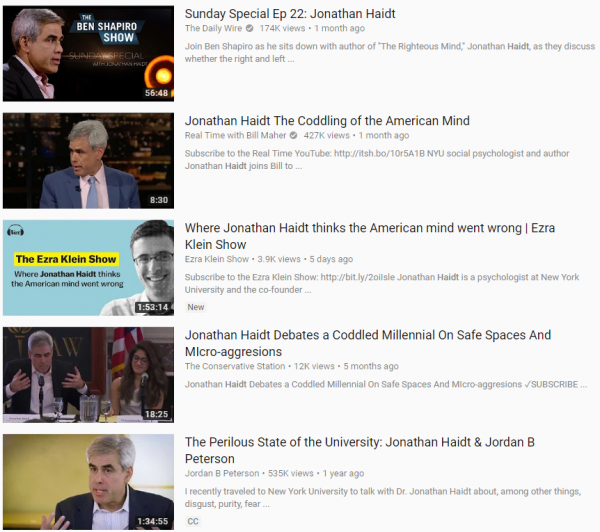
Language Changes Over Time…Shock and Horror!
In a recent tweet, Thiel Capital managing director Eric Weinstein argued that because the words “LGBTQ,” “transphobia,” “hate speech,” “white privilege,” and “transwoman” started being used more recently in human history, this somehow invalidates the “woke stuff millennials talk about.”
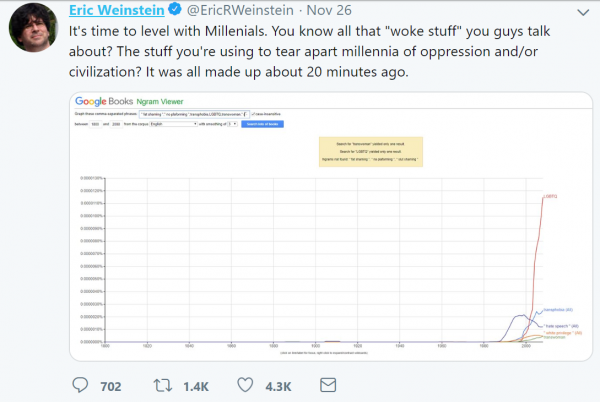
If you’ve read thus far, you probably understand that Weinstein is playing the same game as Brooks and Haidt — mixing a hodgepodge of concepts to argue against the “woke stuff” adults under 40 are talking about, without actually using any specifics besides questioning the validity of what millennials believe in.
The problems with his tweet were promptly addressed by his Twitter followers:


Weinstein’s use of language to negate or question the importance of various issues is similar to how Jordan Peterson, another psychologist embedded in the right and alt-right media circuit, gained prominence.
Peterson’s popularity came after his much publicized criticism of the Canadian Bill C-16, which proposed adding gender identity and gender orientation to the Canadian Human Rights Act. Peterson, who is a Canadian citizen, claimed such efforts would limit “free speech” and criminalize one’s failure to use preferred pronouns.
While videos of Peterson arguing with LGBTQ students and activists propelled him into mainstream culture, little attention was given to the ways in which he mischaracterzied the bill.
As it turns out, C-16 wasn’t about “radical left-wing ideologues” limiting Peterson’s free speech (as he claimed), but about equality for trans and non-gender binary Canadians. This has been explained at length by fellow professors, supporters-turned-critics, and even the Canadian Bar Association.
This account from one of Peterson’s ex-supporters critics is especially revealing:
Following his opposition to Bill C-16, Jordan again sought to establish himself as a “warrior” and attacked identity politics and political correctness as threats to free speech. He characterized them as left-wing conspiracies rooted in a “murderous” ideology — Marxism. Calling Marxism, a respectable political and philosophical tradition, “murderous” conflates it with the perversion of those ideas in Stalinist Russia and elsewhere where they were. That is like calling Christianity a murderous ideology because of the blood that was shed in its name during the Inquisition, the Crusades and the great wars of Europe. That is ridiculous.
In Jordan’s hands, a claim which is merely ridiculous became dangerous. Jordan, our “free speech warrior,” decided to launch a website that listed “postmodern neo-Marxist” professors and “corrupt” academic disciplines, warning students and their parents to avoid them. Those disciplines, postmodern or not, included women’s, ethnic and racial studies. Those “left-wing” professors were trying to “indoctrinate their students into a cult” and, worse, create “anarchical social revolutionaries.” I do think Jordan believes what he says, but it’s not clear from the language he uses whether he is being manipulative and trying to induce fear, or whether he is walking a fine line between concern and paranoia.
Hijacking the Millennial Narrative — a White Male Affair
You might be wondering: why would opinion columnists, psychologists, and managing directors in their 50’s be interested in disproving what millennials talk about in their daily lives or how we identify ourselves?
Why would a national platform allow their columnist to describe the younger generation as “young militants”? Why would a psychologist refuse to acknowledge the economic and political context in which young people are growing up today?
And, perhaps most importantly, why would anyone try to resurrect a rehashed anti-Semitic trope and attack not only progressives and young people with their “cultural Marxist” talking point, but also instill doubt about educational institutions in the the U.S.?
Those people are simply not interested in exploring millennial issues in a fact or experience-based environment. This is why none of them cite credible research about generational theory.
Quite the opposite —Haidt gives credibility to alternative generational labels like iGen, while Brooks chops and screws America’s generations as if “generational theory” has never existed as a field of study. In Brooks’s mind, different generations simply whiff different “atmospheres.”
Such commentators don’t represent anyone other than themselves and the tribe they try to protect, whether that’s “older liberals,” right-wing media pundits, Silicon Valley gender and “free speech” experts, and all the industries and personalities that have profited from, and around, Trump’s ascendance to the presidency.
While they’d like to be perceived as being on the center-left, their blatant anti-intellectualism and creative attempts to bifurcate and smear progressive movements in the U.S. suggest otherwise.
In the context of an administration that is friendly to white nationalists and racists, the stories of 50-something white men bitching about the millennial generation’s progressive demands and fight for equal rights are indicative of how generational lingo can be used to manipulate public opinion and lend credibility to anti-progressive and ageist sentiments.








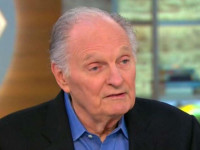


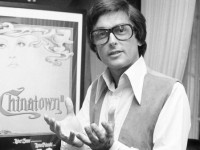








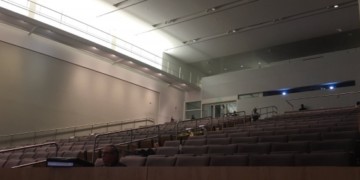

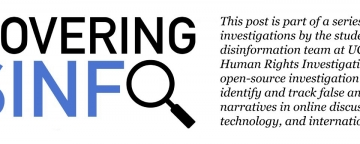





Connect with us